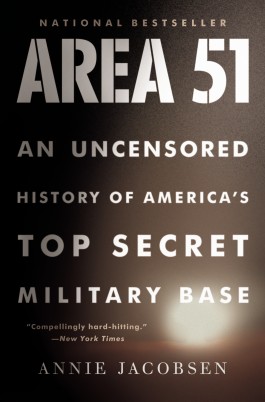SUMMER READ: Area 51 secrets finally revealed, but questions still remain

For those expecting an exposé on little green men and reverse engineering on UFOs, Annie Jacobsen’s intricately detailed book Area 51: An Uncensored History of America’s Top Secret Military Base will be a disappointment. For all others, it’s a quality read, now available in paperback.
Sidestepping science fiction for verifiable fact, the journalist offers a rich account of Area 51’s unique link to the developing and testing of nuclear bombs, aircraft and drones. All of the government agencies and private companies that have been cloaked in secrecy through the years (CIA, United States Air Force, EG&G) are included, but everything is grounded in the basic tenants of sound journalism. This makes Area 51 a wonderfully enticing read, one that answers many questions and continues to confound the deeply skeptical.
Not everything is perfect. The controversial last chapter of the book (spoiler alert) includes a truly out-of-this-world scenario that features Roswell, N.M., Josef Stalin, a Nazi doctor, surgically augmented children, hover technology and complicit human experimentation. There is even brief mention of comatose “guinea pigs” in a “Jell-O-like substance” in “two tubular tanks” at Area 51. This so-called revelation is a difficult journalistic pill to swallow. If true, it begs us to fully explore and investigate the issue of human experimentation in the 20th century. If it’s not true, the story is yet another conspiracy to add to the increasingly large pile of mysteries about Area 51.
Whether or not the fireworks ending has any veracity — and Jacobsen seems convinced of the theory — the last chapter puts a different spin on the previous 300 pages. Like any good mystery, it’s a head scratcher, one that has lit up online discussion forums and will likely continue the debate over Roswell and Area 51 for years to come.
The heart of Jacobsen’s invigorating tale is a recounting of America’s tit-for-tat contest with the Soviet Union during the Cold War. So many questions surrounded the actions of each superpower that it became difficult to keep track of all the deceptions. The United States believed advanced science and technology would win the war, and the race to stay ahead of their Russian counterparts defined a generation of defense budgeting and innovation.
From the U-2 spy plane to a secret MiG plane from Munir Redfa, an Iraqi Air Force colonel, Area 51 was at the forefront of espionage, stealth and aviation developments for many years. The facility hosted many colorful personalities in the desert terrain of Nevada, approximately 75 miles north of Las Vegas. Officially, all of Jacobsen’s information is backed up by a long list of documents, interviews and articles. Still, the government doesn’t recognize that Area 51 even exists. This adds a necessary question mark to just about everything in the book, although it’s fair to say that the writer has come closer than any other person in finally figuring out the enigma of this controversial space.
Jacobsen writes with a detailed eye, but one that allows the reader to follow along with the natural intrigue of the story. Set to the backdrop of the Cold War, Vietnam War and today’s War on Terrorism, the book serves as a simultaneous aviation and military history of the past 65 years, as much as it sheds light on this square in the desert.
There are some areas throughout the tome that feel off topic. The lunar-landing conspiracy theory is great fodder for doubters, but describing an incident in Beverly Hills with Buzz Aldrin feels like a name-dropping, extraneous scene. The story also runs out of steam, mostly because recent activity at Area 51 still remains classified. Not too many people know what happened during the 1950s and 1960s, and fewer people know what happened in the past two decades. The concept behind this disclosure — called “need-to-know” — is described in painstaking detail, and it lies at the heart of the book and its sensational subject matter.
Much credit should be given to Jacobsen for compiling so much interesting, engaging information — some details of which have never been published before. Her assertions, based on firm investigative tools, seem probable and likely.
But that last chapter expands a little too much on the anonymous testimony of one EG&G engineer. Believing that Stalin sent over a flying disc with surgically changed children, just to drive Americans into a panic, is almost as unbelievable as Martians simply crash-landing in New Mexico.
The book highlights the ultimate battle between nonfiction and fiction. Area 51 is a work of nonfiction, but one that allows our minds to keep imagining the possibilities that still exist — whether fictional or not.
By John Soltes / Publisher / John@HollywoodSoapbox.com
-
Area 51: An Uncensored History of America’s Top Secret Military Base
-
By Annie Jacobsen
-
Little, Brown; 523 pages
-
Now available in paperback
-
Rating:





